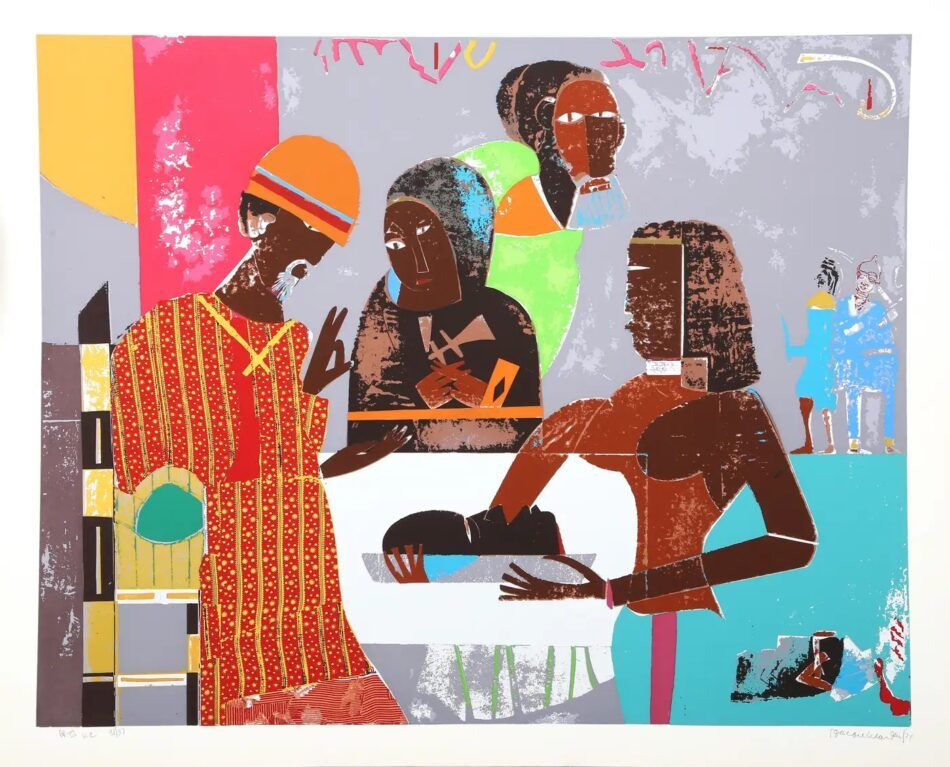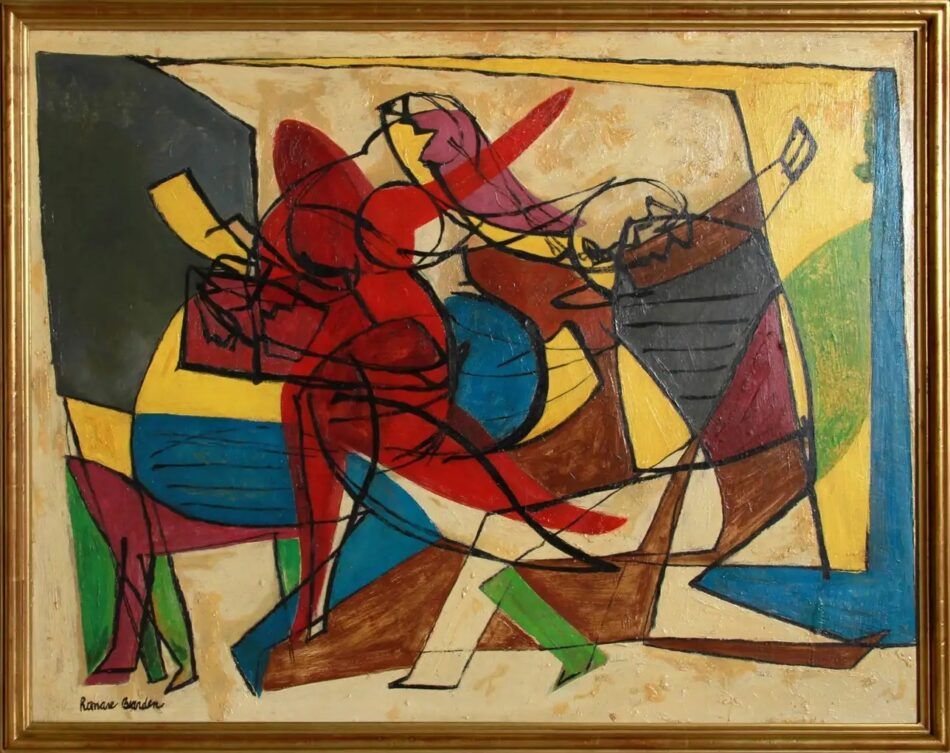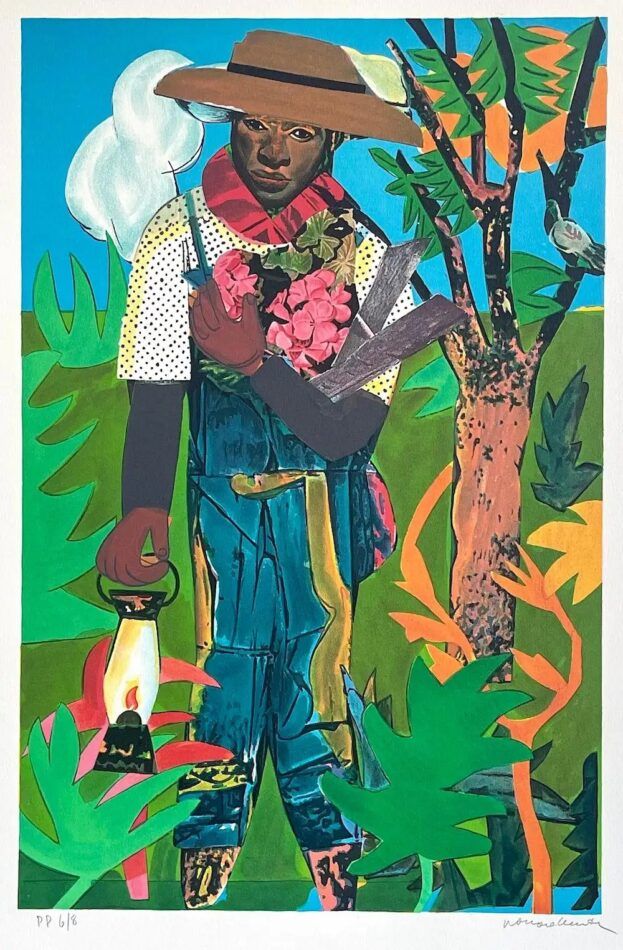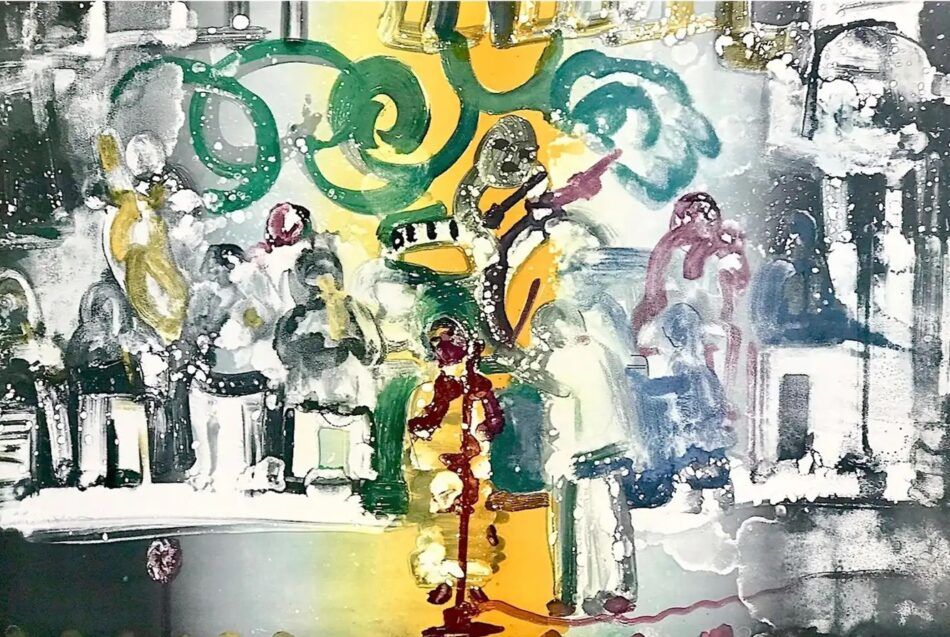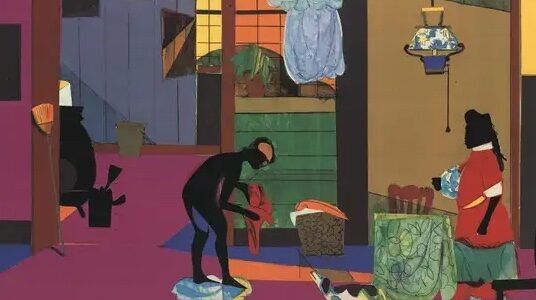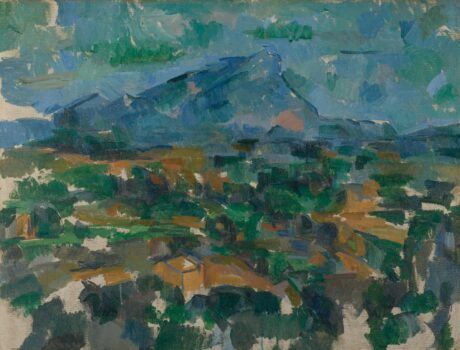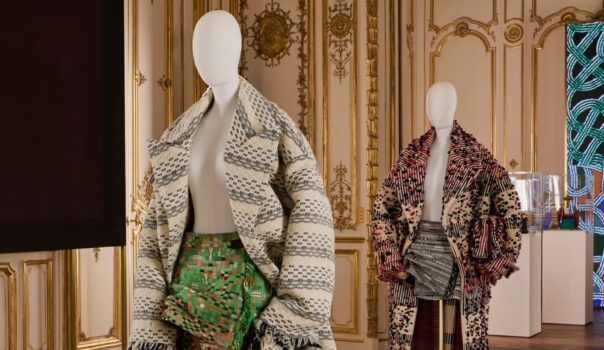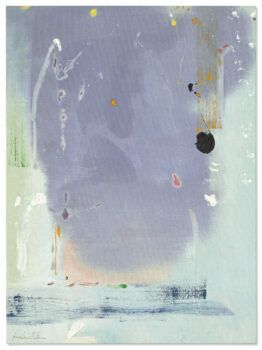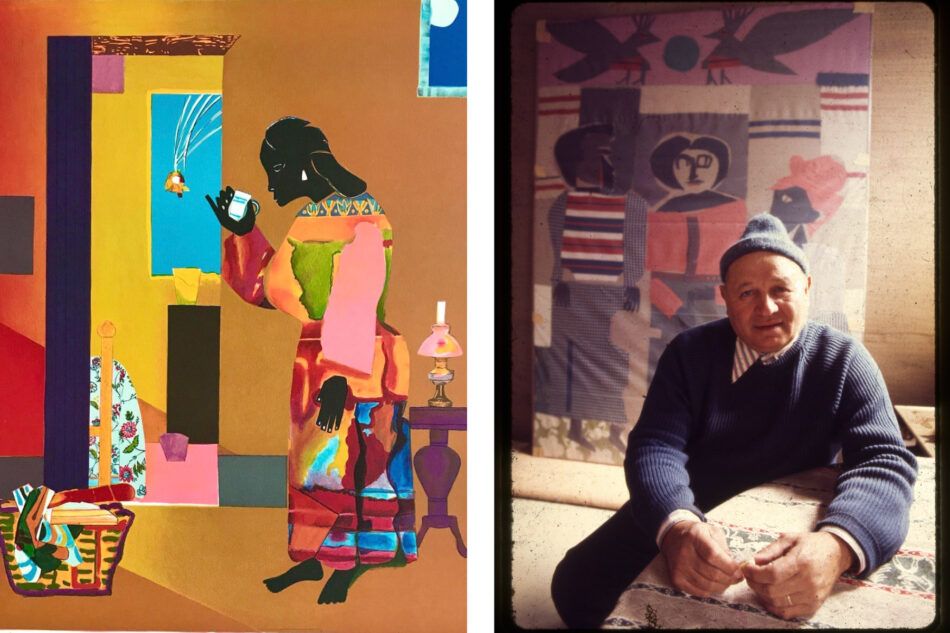
Romare Bearden’s lively artworks celebrate the African American experience in all its complexity — a story pieced together with the same deliberate care and ingenuity he used in crafting his well-known collages.
Through his imaginative merging of photomontage, figure painting and abstraction, Bearden captured the essence of Black life in America. His works are both personal and universal, melding influences to create an aesthetic that was wholly his own.
“His style evokes traditional African aesthetics but blends that with Cubist, modern, Surrealist, Pop art, and even Abstract Expressionist techniques,” says Emma Reinhardt, collections manager at RoGallery, which offers the artist’s work.
From his Southern roots to his childhood immersed in the Harlem Renaissance, Bearden’s biography is as compelling as his oeuvre.
Early Life and Background
Bearden was born on September 2, 1911, in Charlotte, North Carolina, into a family of teachers, activists and local leaders. His parents, Howard and Bessye Bearden, were members of an expanding Black middle class, which had emerged in the South during Reconstruction.
“There was a time in the late 1800s and early 1900s when it was possible for Black Americans to live in the deepest parts of the South and thrive as middle- and upper-class citizens,” says Reinhardt. “Romare Bearden’s parents established themselves in one such community in Charlotte.”
But the period’s relative peace was short-lived, as Jim Crow laws clamped down on upward mobility for marginalized groups. Yearning for greater safety and job opportunities, the family joined the Great Migration northward and settled in New York City’s Harlem neighborhood when Bearden was three years old.
Education and Artistic Training
The move to Harlem changed Bearden’s life trajectory. He grew up surrounded by Harlem Renaissance writers, musicians and thinkers who shaped his worldview and creative process.
Bearden attended New York University in the early 1930s, where he graduated with a degree in education. He had a talent for pitching hardballs and was even asked to try out for the Major League Baseball, as long as he agreed to “pass” for white with his fair skin. Bearden said no to this proposal.
Instead, a passion for art led him to the Art Students League in 1936. There, mentored by the German Dadaist and political caricaturist George Grosz, Bearden honed his drawing and painting skills and became interested in social commentary — a subject that would define his later career.
Early Works and Themes

Bearden’s early paintings, from the 1940s, leaned heavily on social realism. He depicted scenes of urban life, often focusing on the struggles and dignity of working-class African Americans or the free-form compositions of jazz.
These pieces, while less abstract and more literal than his later creations, nevertheless hinted at his growing interest in experimentation in his use of exaggerated figuration and bombastic coloration.
During World War II, Bearded joined the army’s all-Black 372nd Infantry Regiment and served mostly in Europe until 1945.
Transition to Collage
In the 1960s, Bearden’s career took a revolutionary turn. Inspired by the civil rights movement and longing to reconnect with his heritage, he embraced the visual crispness of collage as his primary mode of expression.
Collating torn photographs, magazine clips and painted paper, Bearden crafted works that appeared simultaneously fragmented and cohesive — a visual metaphor for the Black experience in America.
Bearden’s groundbreaking use of collage allowed him to explore memory and identity in brand-new ways. By piecing together bits of photographs and magazine pages — which he often enlarged as black-and-white “Projections” — he created works that were as intellectually engaging as they were visually surprising.
Exploration of African American Culture
From jazz musicians to Southern landscapes, his subjects reflected a wide range of African American cultural themes.
“Mundane daily life is championed for its comforting beauty, the ongoing oppression that African Americans face is recognized, and the spirit of jazz and Black American music is pervasive throughout,” Reinhardt says.
One of his most famous collages, The Block (1971), is a six-panel masterpiece that portrays a Harlem scene in vivid, intricate detail. It captures both the vibrancy and challenges of urban life, with each panel offering a different glimpse into the everyday activities of its residents.
Works like this sealed Bearden’s reputation as a master storyteller.
Adventures in Printmaking
Maureen Turci and her partner, master printmaker Joseph Kleineman, of J K Fine Art Editions Co/Mojo Portfolio, worked closely with Bearden on his prints in the late 1970s and ’80s.
“Romy, as we knew him, lived on Canal Street in New York City, which made it very convenient for him to travel to our printmaking studio, at 55 Van Dam Street and later at 50 Watts Street,” Turci remembers. “He would come by after a day working in his artist studio, in Long Island City, Queens, to review any lithography projects he had going on at our printmaking atelier.”
Turci’s recollections paint a picture of a dedicated artist who was meticulous in his process and collaborative in his approach to making fine-art prints.
She recalls Bearden’s attention to detail during the artistic process: “Romy was always good-natured. He’d show up wearing a cap, dressed in his striped work coveralls, ready to inspect the print in progress, checking the colors we had proofed for him that day, noting any changes he thought needed to be made.”
Later Years and Death
Bearden’s dedication to his craft extended into his later years. “The last printmaking project that we were able to work on with Romare Bearden,” says Turci, “was the limited-edition lithograph entitled Homage to Mary Lou: The Piano Lesson, created in 1984. It was a favorite of Romare’s and a very special lithograph, produced as a fundraiser for his wife Nanette’s dance company.”
Bearden continued to make art and mentor younger creators until his last days. He died on March 12, 1988, in New York City, leaving behind a legacy of innovation and inspiration.
Major Works
The Block (1971)
This six-panel collage captures a single city block in Harlem. Each panel teems with activity and evocative locations: a Baptist church, a hearse driving by, children playing on the sidewalk, people hanging out of apartment windows to chat. Together, they tell a nuanced, layered story of community.
Pittsburgh Memory (1964)
In this collage, Bearden revisits the industrial cityscapes of Pittsburgh, where he spent part of his childhood. He juxtaposes abstract forms with representational elements to form two metallic-looking Cubist faces that reference the silent power and resilience of America’s labor force.
Contribution to African American Art

As a founding member of the Spiral group, a New York–based collective of Black artists formed in 1963 in response to the civil rights movement, Bearden committed to using art as a vehicle for social change.
His work helped to bring African American culture into the art world’s mainstream and inspired generations of artists to embrace their roots.
Recognition and Awards
Bearden’s contributions did not go unnoticed. He received numerous accolades throughout his career, including the National Medal of Arts, in 1987. His works can be found in the permanent collections of major institutions, from the Smithsonian American Art Museum, in Washington, D.C., and New York’s Museum of Modern Art to the Studio Museum in Harlem, which he helped found.
Influence on Contemporary Artists
Today, Bearden’s impact is visible in the works of countless artists who draw from his blending of personal narrative with broader cultural themes in a style brimming with expressionist élan.
In 1969, he cofounded the Cinque Artists Program to give a leg up to creators outside the art world’s inner circle. The initiative is continued today by the Romare Bearden Foundation.
Bearden’s life and work stand as a powerful reminder of art’s ability to celebrate, critique and transform. As Reinhardt concludes, “Romare Bearden’s art is a story that celebrates the perseverance, triumph and potential of Black people in America.”
Frequently Asked Questions about Romare Bearden’s Life and Legacy
What was Romare Bearden famous for?
Romare Bearden is celebrated as one of the most influential American artists of the 20th century. His innovative use of collage and photomontage allowed him to compose powerful depictions of African American culture that pushed back against racial stereotypes while expressing the fragmented feeling of the Black narrative. His works are renowned for their emotional truths, blending elements of history, contemporary society and his own vivid imagination.
What are common themes in artist Romare Bearden’s work?
Bearden often explored themes of Black identity, cultural imprints and resilience. Jazz was a recurring influence in his work, which mirrors the music’s improvisational energy and importance in African American culture. Additionally, he drew on personal memories, literary references and historical events to create his layered compositions. His interest in collage began through experiments with the Spiral group, an art collective focused on race and politics.
What are the major influences on Romare Bearden’s art?
Bearden’s art is deeply rooted in African American culture and history. Key themes include the Great Migration, Harlem’s vibrancy and the spirit of jazz. His influences spanned from Southern American traditions to African tribal masks and European modernism. Surrealist caricature artist George Grosz, his mentor at the Art Students League, ignited in Bearden a lifelong interest in social commentary. Through collage, he explored complex ideas of unity, heritage and identity in ways that resonate with audiences to this day.
How did Romare Bearden contribute to the Harlem Renaissance?
While Bearden’s career peaked a few decades after the Harlem Renaissance, his art reflects its cultural ideals. His works celebrate Black history and pride, aligning with the Renaissance’s focus on empowerment and creative expression. His vivacious portrayals of African American life carried forward the legacy of the era, solidifying its impact on future generations.
What techniques and mediums did Romare Bearden commonly use in his art?
Bearden’s signature technique was collage, in which he skillfully combined original photographs, painted paper fragments and magazine clips to create intricate, layered scenes. He also worked with photomontage, gouache and watercolor, often experimenting with texture and composition to convey dynamic narratives built around African American themes.
What is Romare Bearden’s significance in African American art history?
Romare Bearden stands as a towering figure in African American art, celebrated for his ability to capture the richness of Black life through his pioneering collages. His art not only highlighted the struggles and triumphs of African American communities but also expanded the boundaries of American art by addressing universal themes of resilience, social mobility, personal expression and human connection. Bearden’s brilliant collages continue to inspire artists, collectors and museumgoers worldwide.
